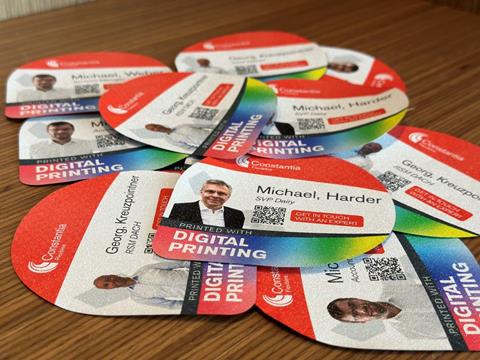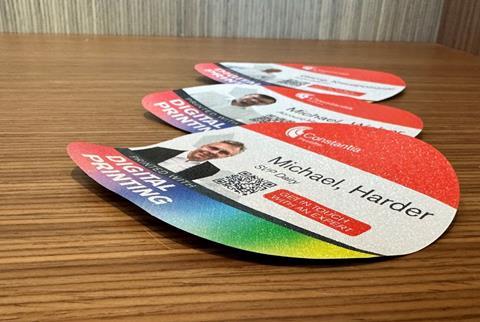At FACHPACK 2024, Constantia Flexibles showcased its “industry-first” aluminium prints, created specifically for die-cut dairy lids. At the event, Elisabeth Skoda sat down with Michael Harder, Senior Vice President Dairy and Thomas Schulz, VP Group Marketing Communication, to learn more about the new technology and the opportunities it can unlock.

Elisabeth Skoda: Starting broadly, what are some of the specific challenges around packaging dairy products?
Michael Harder: The key challenges include ensuring food safety and 100% product protection, providing convenience and easy peelability, and creating packaging that is environmentally sustainable and recyclable, in line with retail design guidelines. Additionally, meeting regulations such as the Single-Use Plastics Directive (SUP) and the Packaging and Packaging Waste Regulation (PPWR) is crucial. The use of alternative materials also poses challenges, particularly due to the non-standard costs they face for now.
Elisabeth Skoda: At FACHPACK 2024, Constantia Flexibles has introduced a new digital printing service specifically for the dairy segment. How does this new technology enhance flexibility and efficiency in packaging compared to traditional methods?
Michael Harder: Of course, digital printing technology is not new, but this printing service is. While it is not exclusive to the dairy segment, it will serve our broader consumer market, with a strong focus on dairy. Unlike traditional methods, digital printing eliminates the need for time-consuming repro work, printing cylinders, or plates. This significantly reduces both preparation time and associated costs. By using CMYK colours, we can print graphics much like a standard home printer. We will match up to 93% of the Pantone scale, and we are offering high flexibility for short runs.
This innovation allows for unprecedented flexibility, enabling rapid graphic changes, shorter lead times, and the ability to accommodate very small print runs, which were previously not feasible. We are confident that we can do rush jobs within five working days of receipt of the design.
We will start with standard materials and we will work on offering more.
Thomas Schulz: The fact that we are using CYMK colours isn’t noticeable for the consumer, they still get a colourful result. It just means that the job gets done quicker. That is the magic and beauty of it.
Elisabeth Skoda: You mention matching up to 93% of Pantone colours, ensuring consistent quality across batches. How important is this for brand consistency, and how does this compare to conventional printing methods?
Michael Harder: The digital print quality we offer compares very favourably with conventional rotogravure and UV-Flexo printing. A big advantage of digital print is reproduction. Since we work with a four-colour process and store print data for follow-up orders, we can ensure consistent reproduction across batches and machines. Additionally, there is no need for manual colour matching of printing inks, which is a common requirement in conventional methods.
Elisabeth Skoda: Are there any sustainability benefits associated with this?
Michael Harder: We believe this solution can support our customers’ targets in many aspects. The use of water-based ink systems eliminates the need for typical solvents, reducing harmful emissions. Additionally, the system minimizes setup waste, and since we print only the required volume, there is no overproduction. Less waste means fewer resources are used, contributing to more sustainable operations. An important aspect is that our Copenhagen site operates entirely on wind energy, making the digital printer’s energy consumption both low and CO2-neutral, which aligns with our sustainability goals and those of our customers.

Elisabeth Skoda: Constantia Flexibles is currently the only flexible packaging company able to digitally print full-surface and water-based on aluminium without compromising sealing conditions. What specific challenges did you overcome to make this possible?
Michael Harder: Achieving this capability was the result of Constantia Flexibles’ dedication to the development of digital printing over the past two decades, with a particular focus on water-based inkjet printing since 2020. Our R&D centre at Constantia Teich, Austria, was equipped with a specialized test machine to support this effort. We developed our printing primer, top coat, and ink system to meet both our high internal standards and market demands. That is a milestone for us, and also for the market on the whole.
Thomas Schulz: Digital printing is of course not brand new to the market. It has been around in a commercialized form for half a decade. But what is brand new is the development that we are now able to print on die cut lids, for instance, and to print matching almost all of colours, and to be using water-based inks to make it more sustainable. It is all these little steps that have upgraded the technology. With 93%, there is room to grow an extra 7%. But it is on such a high level that we feel comfortable and confident to match the high-quality standards of customers.
Michael Harder: In addition, the heat resistance of the ink system with the overlay and the print primer matches the requirements of the dairy industry’s filling lines. We should be able to achieve 250 or 260 centigrate, which has not been possible so far. Many ink systems are PE-based, which makes a big difference in terms of sealability. This is the breakthrough with aluminium – there are no limitations on filling and sealing speed.
Elisabeth Skoda: The technology currently supports printing on aluminium and PET – is printing on other materials in the pipeline?
Michael Harder: We are targeting all aluminium specifications with heat seal lacquer (HSL) and coextrusion (Coex) for most applications as well as on PET for die-cut and reel-fed applications.
Other substrates such as Paper, Polypropylene (PP), and Polyethylene (PE), are currently being developed and will be approved in the future.
Elisabeth Skoda: What are some other sustainable solutions Constantia Flexibles was showcasing particularly in the dairy sector?
Michael Harder: We were focusing fully on our Ecolutions series, which takes a 360-degree approach to sustainability. This includes mono PE solutions, PPCover, and EcoPaperLidding, which replaces the traditional Pap/PET Flexpap for FFS lines. We are also highlighted our award-winning EcoPeelCover—a super-thin die-cut made from Alu25-Coex13, currently the thinnest die-cut lid on the market. In addition, we concentrated on the downgauging of aluminium, combining it with low-carbon aluminium for more sustainable packaging solutions.
We believe in Aluminium and, low carbon aluminium is a high priority. We believe this will change the industry. We aim to move our first products to low carbon aluminium at the beginning of next year.
Elisabeth Skoda: In conclusion, Constantia Flexibles sets out to be a leader in sustainable packaging development, also underlined by the company’s sponsorship of Packaging Europe’s Sustainable Packaging Summit. How does the company’s product development tie in with this?
Michael Harder: Constantia Flexibles’ product development is guided by our slogan, “People, Passion, Packaging,” and is driven by our mission to rethink packaging every day. Our vision is to create packaging that minimizes environmental impact while still ensuring the protection of the products inside. We design for recycling, focusing on recyclable, compostable, and resource-efficient materials to develop sustainable solutions that align with our commitment to both the planet and product protection.
These are our guiding principles, and by sponsoring events like Packaging Europe’s Sustainable Packaging Summit, we reinforce our dedication to driving industry-wide change and promoting more sustainable packaging practices across the board.
Thomas Schulz: We aim to not just talk the talk, but walk the walk when it comes to sustainability. Taking the example of aluminium, of course, we are not responsible for the production, but given that aluminium is such an important product for us, we collaborate with our suppliers to boost sustainable innovation that results in low carbon aluminium. Through the smart usage of green energy, we have managed to lower the carbon footprint of aluminium so much that is now comparable to other substrates, which beforehand, in all fairness, wasn’t achievable.











No comments yet